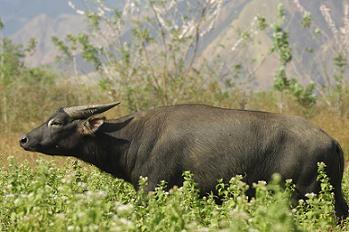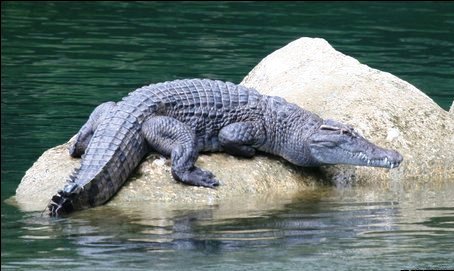All about the Philippines under the sun, which is new, hot, and different.
Showing posts with label WildLife. Show all posts
Showing posts with label WildLife. Show all posts
Sunday, April 22, 2012
Purple Crabs-Palawan
Near the Philippine island of Palawan, Four new species of crab that romp through some wild colors have been discovered.
Scientists at the Senckenberg Research Institute in Germany and De La Salle University in Manila found the four new species of Insulamon freshwater crab genus as a fraction of their Aqua Palawana research program. (Photo CREDIT: © Senckenberg Research Institute)
Labels:
WildLife
Wednesday, September 7, 2011
Largest Crocodile - "Lolong"
In three weeks or twenty-one days of hunting, They captured one of the largest crocodiles in marshes of Agusan del Sur province, Philippines.
Palawan Wildlife Rescue and Conservation Center announced last Monday the huge 21-ft. saltwater crocodile, weighing 600-pounds. Guinness World Records lists the Australia world-record holder at 17 feet and 11.75 inches. Saltwater crocodiles can live for more than 100 years and grow up to 23 feet.
Palawan Wildlife Rescue and Conservation Center announced last Monday the huge 21-ft. saltwater crocodile, weighing 600-pounds. Guinness World Records lists the Australia world-record holder at 17 feet and 11.75 inches. Saltwater crocodiles can live for more than 100 years and grow up to 23 feet.
Labels:
Crocodile,
Guinness Record,
WildLife
Wednesday, September 22, 2010
Manila Zoo-Philippines Wildlife
Philippines oldest Zoo, which opened back in July 1959.
 Address is located at the Adriatico Street, Quirino Avenue, Manila.
Address is located at the Adriatico Street, Quirino Avenue, Manila.
Manila Zoo opens from 8 am to 6 pm every day.
 Address is located at the Adriatico Street, Quirino Avenue, Manila.
Address is located at the Adriatico Street, Quirino Avenue, Manila.Manila Zoo opens from 8 am to 6 pm every day.
Monday, September 21, 2009
Pearl of Lao Tzu
Pearls of God, also called the Pearl of Lao Tzu, is the pearl of the largest the world has ever known.
This pearl was discovered by a diver Muslim Filipinos in the island of Palawan, Philippines on May 7 1934 and is derived from the giant clams of the familia Tridacnidae.
Weighing 6.37 pounds, length is 23.8 inches and the price is expected to reach 40 million U.S. dollars. Pearls of God now not exhibited to the public and is now preserved as part of the heritage inventory Victor M. Barbish, who bought it in 1980.
This pearl was discovered by a diver Muslim Filipinos in the island of Palawan, Philippines on May 7 1934 and is derived from the giant clams of the familia Tridacnidae.
Weighing 6.37 pounds, length is 23.8 inches and the price is expected to reach 40 million U.S. dollars. Pearls of God now not exhibited to the public and is now preserved as part of the heritage inventory Victor M. Barbish, who bought it in 1980.
Labels:
WildLife
Sunday, March 15, 2009
Philippine Tarsier
The Philippine tarsier is very peculiar small animal which could be found, only in the province of Samar, Leyte, Bohol, and Mindanao. Its scientific name is Tarsius syrichta and also known as "mamag", "mago", "magau", "maomag", "malmag" and "magatilok-iok". Tarsier lives on a diet of insects and mostly active at night.

The Philippine tarsier has a gray fur and a nearly naked tail (232 mm). The middle finger is elongated. Head and body length are around 118-149 mm.

The Philippine tarsier has a gray fur and a nearly naked tail (232 mm). The middle finger is elongated. Head and body length are around 118-149 mm.
Labels:
WildLife
Pitcher :Rat Eating Plant
“A spectacular new species of Nepenthes L.(Nepenthaceae) pitcher plant from central Palawan, Philippines” was published in the Botanical Journal of Linnean Society in February 2009.

The pitcher plant is among the largest of all pitchers and is so big that it can catch rats as well as insects in its leafy trap.

The pitcher plant is among the largest of all pitchers and is so big that it can catch rats as well as insects in its leafy trap.
Tuesday, December 9, 2008
Mindoro Dwarf Buffalo
The tamaraw or Mindoro dwarf buffalo is the most endangered cattle from the lineage of Asian buffaloes (Bubalus ) and is found only on the island of Mindoro in the Philippines.
The tamaraw is smaller than the water buffalo ( Bubalus bubalis ) and is somewhat similar to the carabao , a domesticated form of the water buffalo and the national animal of the Philippines. In contrast to the carabao the tamaraw what is more hairy, he has horns in a V-shape and light markings on its head.
The tamaraw is smaller than the water buffalo ( Bubalus bubalis ) and is somewhat similar to the carabao , a domesticated form of the water buffalo and the national animal of the Philippines. In contrast to the carabao the tamaraw what is more hairy, he has horns in a V-shape and light markings on its head.
Thursday, September 11, 2008
Philippine Eagle
The Philippine eagle or monkey eagle ( Pithecophaga jefferyi ) is a very large and powerful species from the family of the Accipitridae. The genus Pithecophaga is monotypic with the Philippine eagle is the only eagle Art The Philippines is an endemic to the Philippines and lived their primary forests, secondary forests and gallery forests.
The main foods of the Philippines eagle are arboreal mammals, besides, other mammals and larger birds and reptiles eaten. Due to continuous and rapid habitat destruction and hunting, according to the Philippine Eagle is IUCN threatened with extinction ( critically endangered ). The total population is estimated at-large uncertainties still about 90-250 pairs, maximum, he could comprise 340 pairs.
The main foods of the Philippines eagle are arboreal mammals, besides, other mammals and larger birds and reptiles eaten. Due to continuous and rapid habitat destruction and hunting, according to the Philippine Eagle is IUCN threatened with extinction ( critically endangered ). The total population is estimated at-large uncertainties still about 90-250 pairs, maximum, he could comprise 340 pairs.
Labels:
WildLife
Wednesday, June 11, 2008
Philippine Crocodile
The Philippine crocodile ( Crocodylus mindorensis ) is a kind of genuine crocodile (Crocodylidae). Compared to all the other crocodiles in the Pacific area is characterized by the Philippine crocodile from a very broad muzzle that is reinforced with up to 68 teeth, and large armored scales in the neck and back area.
With a maximum of three meters body length in males expemplary it one of the smaller species of crocodile. The females of this species are small, up to 1.5 meters and up to 15 kg body weight. The behavior of the Philippine crocodile is described as shy and harmless to humans, only provocations react aggressively.
With a maximum of three meters body length in males expemplary it one of the smaller species of crocodile. The females of this species are small, up to 1.5 meters and up to 15 kg body weight. The behavior of the Philippine crocodile is described as shy and harmless to humans, only provocations react aggressively.
Tuesday, May 13, 2008
Dwarf Pygmy Goby
The Pandaka pygmaea ( English: dwarf pygmy goby) is a type of tropical fish that live in fresh water from the family Gobiidae. This one was once considered the smallest fish in the world, reviewed the masses, and also one of the shortest fresh water fish. The old man takes long to 1.1 cm, while the women grow up to 1.5 cm. The usual weight, it is from 4 to 5 mg. This is called bia and tobias in the Philippines.
Pandaka pygmaea is primarily a Philippine species that was endemic in the rivers of Malabon, Metro Manila. It used to frequent shady river banks in Rizal Province of Luzon, Philippines. It has also been collected in the sea at Culion Island, near Palawan, Philippines. It as well thrives in brackish waters and mangrove areas of Indonesia, and Singapore (1992). It was imported into Germany in 1958.
Pandaka pygmaea is primarily a Philippine species that was endemic in the rivers of Malabon, Metro Manila. It used to frequent shady river banks in Rizal Province of Luzon, Philippines. It has also been collected in the sea at Culion Island, near Palawan, Philippines. It as well thrives in brackish waters and mangrove areas of Indonesia, and Singapore (1992). It was imported into Germany in 1958.
Labels:
WildLife
Sunday, March 2, 2008
Sugarcane
The term sugar refers to a set of species of plants of the family of Poaceae and the genus Saccharum. They are grown for their stems, which is extracted from sugar. With an annual production volume of more than 1.7 billion tons, these are the first crops globally, with nearly 23% of the total mass produced in agriculture in the world.
The juice of the trunk is the main source of sugar. After harvesting the cane, passes under shredders blades, then move to the mill. This juice is debugged by a series of filters, and then subjected to a fining treatment and hence is placed in vacuum cooking tanks, wherein the juice is concentrated, and finally, crystallized sugar juice. Once crystallized sugar, remaining water is removed thus leaving the common white sugar that is commonly known.
The juice of the trunk is the main source of sugar. After harvesting the cane, passes under shredders blades, then move to the mill. This juice is debugged by a series of filters, and then subjected to a fining treatment and hence is placed in vacuum cooking tanks, wherein the juice is concentrated, and finally, crystallized sugar juice. Once crystallized sugar, remaining water is removed thus leaving the common white sugar that is commonly known.
Labels:
WildLife
Tuesday, January 15, 2008
Rice
Rice is one of the seven most important cereals and forms a staple food source for a large part of humanity. Various cereals, the trade as wild rice are referred belong botanically to rice genus.
Rice is grown in various ways. The upland rice without flooding the field, differs from flooded rice where the water level is not controlled, and irrigated rice where the presence of water and its level is controlled by the farmer. Field-grown rice is called paddy.
Rice is grown in various ways. The upland rice without flooding the field, differs from flooded rice where the water level is not controlled, and irrigated rice where the presence of water and its level is controlled by the farmer. Field-grown rice is called paddy.
Subscribe to:
Comments (Atom)








